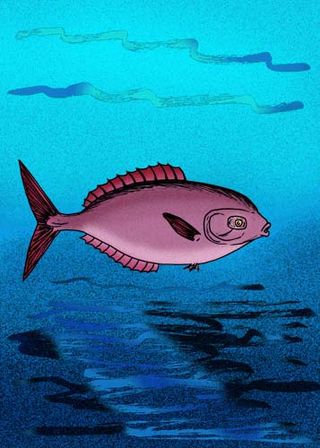
The Claroteidae are a family of catfish found in Africa. This family was separated from Bagridae. However, the monophyly of the family is sometimes contested.

The Ictaluridae, sometimes called ictalurids, are a family of catfish native to North America, where they are an important food source and sometimes fished for sport. The family includes about 51 species, some commonly known as bullheads, madtoms, channel catfish, and blue catfish.

The Ariidae or ariid catfish are a family of catfish that mainly live in marine waters with many freshwater and brackish water species. They are found worldwide in tropical to warm temperate zones. The family includes about 143 species.

Galeichthys is a genus of sea catfishes in the family Ariidae, the only genus in the subfamily Galeichthyinae. It includes four predominantly marine species distributed in Southern Africa and northwestern South America:

Gasteroclupea is a genus of prehistoric ellimmichthyiform fish that is distantly related to modern anchovies and herrings. It contains one species, G. branisai. It inhabited freshwater or estuarine habitats across South America during the Campanian and Maastrichtian stages of the Late Cretaceous period, and it briefly survived beyond the K-Pg boundary into the Danian stage of the Paleocene, making it among the few genera from its order to survive into the Cenozoic. Fossils of the genus have been found in the Yacoraite Formation of Argentina, the Chaunaca Formation, Santa Lucía Formation, and El Molino Formation of Bolivia, and the Navay Formation in Venezuela.

Andinichthyidae is a prehistoric family of basal catfishes from the Cretaceous to Eocene of South America.

Batrachocephalus mino, the beardless sea catfish, is the only species of catfish in the genus Batrachocephalus of the family Ariidae. This species occurs in marine and brackish waters of Bay of Bengal, and parts of the western central Pacific, in coastal waters, estuaries, and lower reaches of rivers. It is distributed from Pakistan, India, Sri Lanka, Bangladesh, Myanmar, Malaysia, Thailand, to Indonesia.
Eaglesomia is an extinct genus of freshwater catfish, most likely of the family Claroteidae, that inhabited western Africa during the Eocene. It contains a single species, E. eaglesomei, known from the presumably Lutetian-aged marine Oshosun and Ameki Formations of Nigeria.

Beerichthys is an extinct genus of prehistoric marine ray-finned fish. It contains a single species, Beerichthys ingens, that was a member of the Ypresian London Clay fauna of lower Eocene England.
Eobuglossus is an extinct genus of marine flatfish that lived during the Eocene. It contains a single known species, E. eocenicus, known from the late Lutetian-aged Mokattam Formation of Egypt, with its fossils recovered from the historically important Tura quarry.

Eoholocentrum is an extinct genus of prehistoric marine ray-finned fish that lived during the early Eocene. It contains a single species, E. macrocephalum, known from the Early Eocene of Monte Bolca, Italy. It resembled and was closely related to modern squirrelfishes and soldierfishes, and appears to have been more closely related to squirrelfishes. It can be considered a basal or stem member of the Holocentrinae.

Berybolcensis is an extinct genus of prehistoric marine ray-finned fish that lived in the early Eocene. It contains a single species, B. leptacanthus, from the Monte Bolca lagerstatten of Italy. It was a member of the Holocentridae, making it related to modern squirrelfish and soldierfish, although it was more basal than either, and is thought to have diverged from their common ancestor around the Cretaceous-Paleogene boundary. It is thought to be related to Tenuicentrum, another basal holocentrid from the same formation.
Berycomorus is an extinct genus of prehistoric marine ray-finned fish that lived during the late Eocene epoch. It contains a single species, B. firdoussi, from the Pabdeh Formation of Iran.

Balistomorphus is an extinct genus of prehistoric triggerfish during the early Oligocene epoch in what is now Canton Glarus, Switzerland, where fossils are known from the Matt Formation. It inhabited the marine environment of the Paratethys.

Blabe is an extinct genus of small, prehistoric ray-finned fish probably belonging to the family Serranidae that lived during the middle division of the Eocene epoch of Egypt. It has a single known species, B. crawleyi, known from the Upper Lutetian Mokattam Formation limestone of the ancient Tura quarry.
Diaphyodus is an extinct genus of prehistoric marine ray-finned fish, generally considered a drumfish, from the Late Paleocene and Eocene, and potentially to the mid-Oligocene of Europe and North America.

Eolates is an extinct genus of prehistoric lates perch from the Paleogene of Europe. It contains three species, two marine and one freshwater, known from the early-middle Eocene and Late Oligocene.
Egertonia is an extinct genus of prehistoric marine and estuarine ray-finned fish known from the Late Cretaceous to the middle Eocene. It contains one known species, E. isodonta, although indeterminate remains potentially referable to other species are also known. It was a member of the Phyllodontidae, an extinct family of elopomorph fish with crushing tooth plates, which are the primary remains found of the genus.

Qarmoutus hitanensis is an extinct ariid catfish whose fossils were first discovered in Birket Qarun Formation, Wadi Al-Hitan, Egypt. It lived during the Eocene period around 37 million years ago, and its body length is estimated to be about 6.5 feet long.

Hesham Sallam is an Egyptian paleontologist and the founder of the Mansoura University Vertebrate Paleontology Center (MUVP-C), the first vertebrate paleontology program in the Middle East. He works as an associate professor at the American University in Cairo and Mansoura University. Sallam led the discovery and description of Mansourasaurus shahinae, a species of sauropod dinosaur from Egypt, which has improved understanding of the prehistory of Africa during the latest Cretaceous period. His work has helped popularize paleontology in Egypt.














